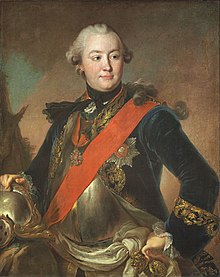Grigory Orlov | |
|---|---|
 Count Grigory Orlov, by Fyodor Rokotov | |
| Coat of arms |  |
| Tenure | 1761 – 1772 |
| Full name | Grigory Grigoryevich Orlov |
| Other titles | Count |
| Known for | Overthrowing Peter III |
| Born | October 17, 1734 Bezhetsky Uyezd, Tver Governorate, Russian Empire |
| Died | April 24, 1783 (aged 48) Moscow, Moscow Governorate, Russian Empire |
| Buried | Yuriev Monastery |
| Nationality | Russian |
| Residence | List of residences: – Estates in Kazan and Moscow governorates |
| Noble family | Orlov |
| Issue | Alexei Grigorievich Bobrinsky |
| Personal details | |
| Spouse | Ekaterina Nikolaevna Zinovieva |
| Parents |
|
| Occupation |
|
| Awards | Order of St. Alexander Nevsky (1762) Order of St. Andrew (1763) Order of St. Vladimir 1st class (1782) |
| Military service | |
| Allegiance | |
| Branch/service | |
| Years of service | 1749 – 1783 |
| Rank | General-in-chief |
| Commands | Izmailovsky Life Guards Regiment Preobrazhensky Life Guards Regiment Semyonovsky Life Guards Regiment Life Guard Horse Regiment |
| Battles/wars | |

Hermitage Museum
Prince Grigory Grigoryevich Orlov (Russian: Григорий Григорьевич Орлов; 17 October 1734 – 24 April 1783[a]) was a favourite of the Empress Catherine the Great of Russia, Prince of the Holy Roman Empire (1772), state and military figure, collector, patron of arts, and General-in-Chief.[1]
He patronised M. V. Lomonosov, D. I. Fonvisin, V. I. Bazhenov and gave them financial support. Honorary member of the Imperial Academy of Arts (since 1765). He collected paintings (including Rembrandt, P. P. Rubens, Titian), sculpture, Chinese, Japanese and Russian porcelain, hunting weapons, etc. (Orlov's collection has been preserved almost completely; it is now in the State Museum-Reserve "Gatchina" of the eponymous city). A large landowner, particularly of the Gatchina manor, where Orlov commissioned the construction of a palace and a landscape garden.[1]
He became a leader of the 1762 coup which overthrew Catherine's husband Peter III of Russia and installed Catherine as empress. For some years he was virtually co-ruler with her, but his repeated infidelities and the enmity of Catherine's other advisers led to his fall from power.
Cite error: There are <ref group=lower-alpha> tags or {{efn}} templates on this page, but the references will not show without a {{reflist|group=lower-alpha}} template or {{notelist}} template (see the help page).
- ^ a b Fedyunina 2023.